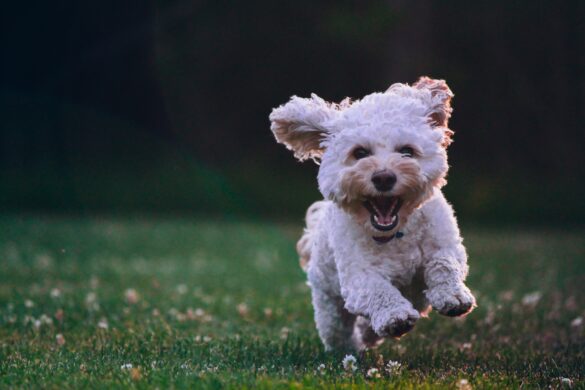Introduction to fluffy dog breeds
While it’s true that no matter the breed, everyone has their favorite kind of dog, there are certain “looks” that get more attention than others. And if you’re the type to gush over a dog with a coat as soft and billowy as a cloud, you’re in luck. Many different dog breeds fall under this category. Petting one is like running your hands through soft, thick fur, and their fluffy appearances make them look like cuddly stuffed animals (some even resemble teddy bears).
You want to adopt a fluffy dog, but you can’t decide which breed would be best for you and your family. Take a peek at our shaggy favorites, and get ready to bring some fluff into your home!
Alaskan Malamute
The robust working breed known as the Alaskan Malamute is sled dog employed for sledding, hiking, and backpacking across the challenging arctic landscape. They perfectly encapsulate a big, fluffy dog.
These dogs are a hassle in a household with children because of their propensity to tug, dig, chase, and shed.
It takes years of teaching to get them to give up their stubbornness because they are quite independent. Given that, novice owners are not advised to get this dog.
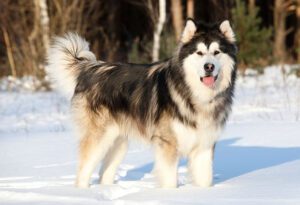
Image Credit- Getty Images
Affenpinscher
Affenpinschers are brave, self-assured fluffy dogs. Given that it belongs to the Toy group and barely weighs about 10 pounds when fully grown, this would sound absurd. But this dog is a Great Dane in its thoughts!
The Affenpinscher, also referred to as a monkey terrier because of how it looks, has a long history that dates back to the 17th century.
They were employed to hunt down mice and rats in stables in Germany. To catch these rodents, they could quickly squeeze into tight areas. They eventually made their way into people’s homes to provide the same function. They then became devoted friends of the family members.
This breed gets along well with adults and older children. Although they take the security of their family seriously, they are also renowned for making jokes and making everyone laugh.
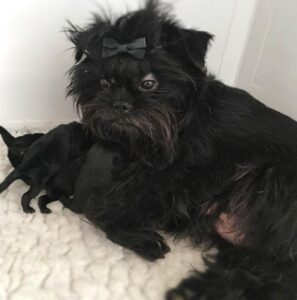
Image Credit- Getty Images
Akita Spitz
The Akita is a huge, powerful working/hunter dog that originated in the northern Japanese mountains at some point in the 17th century. The imperial family and the court once retained only this breed as a formidable hunting dog, giving it its name after the Akita prefecture where it originated.
The Akita also has webbed toes to help it move on the snow, a fox-like face, and a thick, furry tail that loops back over its body.
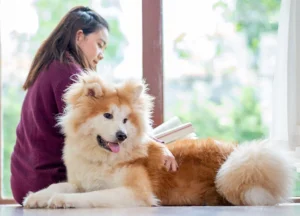
Image Credit- Getty Images
American Eskimo Dog
With all-white or biscuit fur, stunning black eyes, and a highly arched, upturned tail that bends back over the body, the American Eskimo dog is one of the vivacious and alert fluffy dog breeds.
Despite its name, this breed has absolutely nothing to do with the Inuit. Instead, immigrants to the Midwest in the 19th century developed it from the German Spitz.
This breed, which was initially created as a farm dog, later gained popularity as a performer in road shows and circuses. Due to widespread anti-German sentiment in the country following America’s entry into World War I, the name was changed to American Eskimo.
People who seek a lovable, friendly, and active companion in their homes might consider this breed.
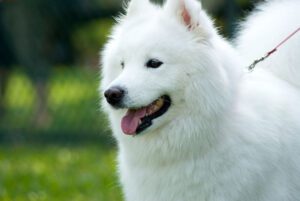
Image Credit- Getty Images
Australian Shepherd
Australian Shepherds enjoy spending a lot of time outside since they are natural herders. They are weatherproof, thanks to their double coat.
They have the most exquisite coats: long, fluffy white tufts with blue and scarlet flecks thrown in. By brushing them every day before they shed, you can reduce the amount of fur that ends up on your couch.
It continues to be one of the more well-liked breeds in the United States, according to the American Kennel Club.

Image Credit- Getty Images
Barbet
Although technically a Curly-Haired Breed, the Barbet can also be classified as “fluffy.”
This medium-sized breed is bursting with affection and humor. They completely succeed in training and agility thanks to their kindness and intelligence. To gratify their owners is their main goal.
The Barbet is a working breed; thus, they require a source of entertainment or a “task” to keep them occupied. Otherwise, this dog is prone to become bored and mischievous.
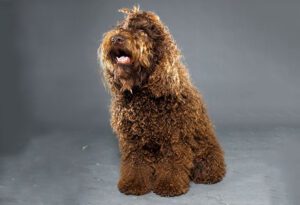
Image Credit- Getty Images
Bearded Collie
Bearded Collies are a purebred canine that were originally bred in Scotland for herding sheep and calves. It has been conditioned to survive in any environment, on any surface.
These dogs compete in a variety of dog sports, including agility and rally, and they are quite active.
Bearded collies are among those fluffy dog breeds that require a lot of grooming and are frequently challenging to groom.
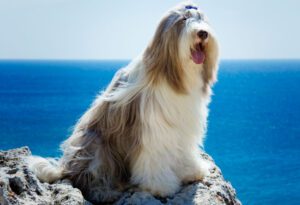
Image Credit- Getty Images
Bernese Mountain Dog
The Bernese mountain dog, which gets its name from being from the canton of Bern, is a huge, powerful dog that can grow to be 27 inches in height at the shoulder. It has a long, thick fluffy coat that blends three colors—jet black, white, and rust—giving it a regal appearance.
The Bernese mountain dog flourishes best in chilly climates, which is especially convenient given its thick coats of fur. They are well-known for being amiable creatures who get along well with the majority of families they inhabit. However, they have a reputation for becoming extremely connected to a single person they are close to.
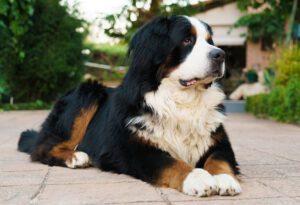
Image Credit- Getty Images
Bichon Frise
The Bichon Frise, the original puffball dog, is almost hysterically adorable with its billowing white fur and black button eyes and nose. And although they bound through the dog bark with all that fur blowing in the breeze, Bichons are typically low shedders and, while not completely hypoallergenic, are still a decent option for anyone with minor pet allergies.
These little divas visit the groomer frequently because they require frequent trimming to keep their teddy bear appearance. However, Bichons are not diva-like dogs; instead, they adore everyone they come into contact with!
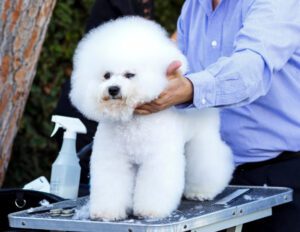
Image Credit- Getty Images
Bolognese
The Bolognese has cute, white, fluffy coats, and they resemble the Bichon Frise. The Bolognese, in contrast to the Bichon Frise, is generally peaceful, timid around strangers, and irritable if left alone for extended periods of time.
Many Bolognese owners shorten their dogs’ coats to make maintenance easier, but if you prefer to let your dog’s hair grow naturally, frequent grooming sessions may be necessary to maintain it clean and trimmed around the face.

Image Credit- Getty Images
Bouvier des Flandres
The Bouvier Des Flandres is also known as the vuilbaard (dirty beard), koehond (cow dog), and toucher de boeuf or pic (cattle driver).
This large, dominant dog, which has been used to herd cattle in Europe since the middle ages, is generally a friendly canine. As long as you take care of his coat, which requires brushing a few times a week, you may train and socialize him early to prevent overprotection, and he will become a lovely family dog.
Throughout history, this versatile dog has taken on a variety of duties. It was initially created to aid farmers in driving cattle, guarding the land, driving sheep, and pulling carts. Later, it was used for police duties, search and rescue missions, guiding the disabled, and as a general home friend.

Image Credit- Getty Images
Caucasian Shepherd
Caucasian Mountain dogs come in two varieties: the mountain type and the stepped type. Compared to the stepped variety, which has a short coat and is smaller, the mountain type is heavier and has a longer coat.
When it comes to defending their family, Caucasian Mountain dogs are brave, certain, and fearless. But they also show their owners kindness, devotion, and love.
For hundreds of years, people have utilized these dogs to guard both property and livestock that were being hunted by wolves or coyotes. They serve as prison guard dogs in Russia, nevertheless.
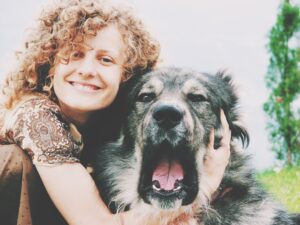
Image Credit- Getty Images
Chow Chows
The Chow Chow has fluffy coats among all breeds and has an undeniably attractive appearance like a teddy bear.
These dogs, however, are reputed to have a very independent character, so they may be everything but cuddly. They are known to be very protective and frequently show suspicion toward strangers and other animals.
Your Chow Chow will learn to tolerate children and strangers with early socialization and training. However, this dog will lose patience without such early instruction. Therefore, elderly families and knowledgeable owners and trainers are advised if you adopt an older Chow Chow.
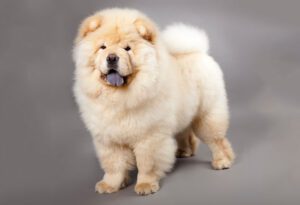
Image Credit- Getty Images
Cockapoo
As its name suggests, the Cockapoo is a cross between a Cocker Spaniel and a Poodle, and it shares the best characteristics of both parent breeds.
Because of their intelligence and warmth, they are easy to train and make fantastic pets for any household.
It’s tough not to smile at their silly behaviour because of their infectious ability to find humor in any setting. So what do you think of those bulky, fluffy coats? It won’t be too difficult to care for, but you’ll need to brush it often and give it the occasional wash.
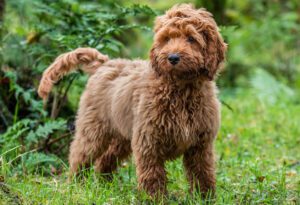
Image Credit- Getty Images
Coton De Tulear
Cotons may look cute and cuddly with their soft fur, but they’re actually very like Velcro in that they’ll stick to you no matter where you go. That’s because this dog wants nothing more than to be by your side.
Cotons are recognized for both their pleasant and tranquil demeanor as well as their high degree of intelligence. They become quite accommodating to your schedule as long as you can endure them following you around all day.

Image Credit- Getty Images
English Mastiff
The coat of an English Mastiff has two layers: a short, dense undercoat and a long, straight outside coat. By nature, English Mastiffs are brave and curious.
Since an English Mastiff puppy is likely to misbehave, early socialization and puppy programs are essential. Since they are kind companions and passive family defenders, English Mastiffs make wonderful family dogs.
These bold but well-behaved dogs can adapt to almost any setting. They don’t need a big house, but they do need some more room.

Image Credit- Getty Images
Eurasier
With chow, Samoyed, and the similarly fluffy keeshond in their pedigree, it’s clear where the Eurasier gets his stunning coat.
Like this newer species, which has a laid-back disposition and is renowned for being affectionate, level-headed, and clever, he only has to be bathed around once a month and brushed once a week.
The Eurasier, whose name indicates his European and Asian ancestry, often develops strong bonds with his human family, making him unsuitable as an outdoor dog.

Image Credit- Getty Images
German Spitz
This small ball of fluff sheds as you’ve never seen before twice a year, and then it stops entirely (until the next time). The German Spitz has one of the happiest faces in the animal kingdom and a double coat. They make excellent, albeit tiny, watch dogs because they are vigilant and tenacious.

Image Credit- Getty Images
Finnish Lapphund
These adorable little fuzzies are a hard-working herding fluffy dog breed that originated in Lapland, Finland (hence the name).
However, the Lapphund has now given up reindeer herding in favor of a more comfortable way of life spent close to loved ones.
These are exceptionally friendly companions who excel in obedience and agility thanks to their desire to please. They can shed lots of furs, though, and they do need a lot of exercise and have a strong barking instinct.
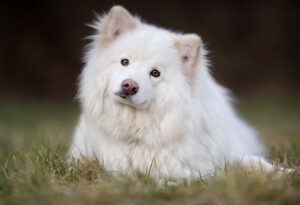
Image Credit- Getty Images
Golden Retriever
Golden retrievers are known for their amiable, laid-back disposition, but they do have a tendency to be fluffier as puppies. Despite the fact that officially goldens only shed sometimes, any owner will tell you that those long, golden-blonde hairs appear all the time. Their long, lavish adult coats, however, can be just as plush and cuddly.
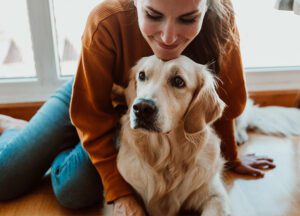
Image Credit- Getty Images
Havanese
It’s not always what it seems. The Havanese may appear to be a cold-weather dog due to his long, velvety coat. But this well-liked, devoted breed originated in Cuba, and its coat actually shields it from the heat and sunlight.
Due to their reduced shedding, Havanese are a suitable choice for people who have allergies. But regular combing of that long fur is necessary. A few times a week, you should brush them out to remove the shed undercoat.
Fortunately, if you decide to trim a Havanese’s fur, a shortcut will still look adorable on them!
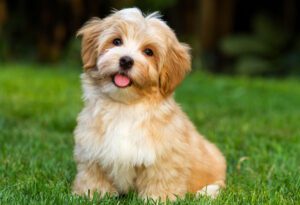
Image Credit- Getty Images
Irish Water Spaniel
The Irish water spaniel, while still a rare breed according to the American Kennel Club, is highly sought after due to its many admirable traits.
The Irish Water Spaniel with curly hair, is adventurous and up for everything. Additionally, because these water dogs were bred to spend extended periods of time in the water, their coats have become waterproof. It merely implies that their oil glands, which help to repel water, are more active.
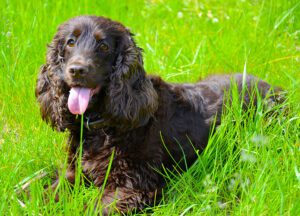
Image Credit- Getty Images
Japanese Spitz
The Japanese Spitz doesn’t shed a lot throughout the year, unlike some seasonal shedders. These dogs make wonderful friends since they are self-assured, devoted, and smart. These dogs have exceptionally fluffy manes and beaming faces, just like the German Spitz.

Image Credit- Getty Images
Keeshond
These dogs are gregarious, devoted dogs because they were raised in Holland to guard ships along waterways. Keeshond coats are thick poofs of fur that are ideal for relaxing on the couch after a hard day or racing around in cold weather.
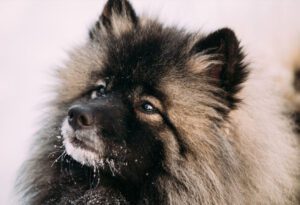
Image Credit- Getty Images
Lhasa Apso
Lhasa apsos, known as “bearded lion dogs” in their native Tibet, once guarded lofty Buddhist monasteries. They are constantly prepared to warn their family members and keep them safe in the home.
Despite the fact that their long, fluffy, silky coats don’t shed, they still require frequent brushing and a bath every two weeks. Their long, free-flowing fur can be left that way, or you can give them a brief “puppy cut” to highlight their adorable eyes.

Image Credit- Getty Images
Leonberger
Leonbergers are giant, silly fluffy dogs with all sorts of personalities, and they’re always looking for the next bit of trouble.
You may need a lot of patience to train them because of their large size and boundless enthusiasm. The bright side is that they make up for it with their boundless love for their family and limitless supply of hilarious pranks.
Leonbergers are highly bright despite their humorous tendencies; with proper training and lots of exercise, these dogs may do well in competitions and make wonderful family pets.
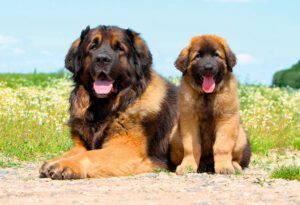
Image Credit- Getty Images
Newfoundland
They are praised for being a “gentle giant” and are known for their tremendous loyalty and composure. The primary difficulty in caring for a Newfoundland is actually its enormous size, which also causes an extraordinary quantity of drooling and shedding.
These are multi-talented working canines that are utilized for rescue operations, human therapy, or hauling equipment through difficult terrain due to their temperament and strength.
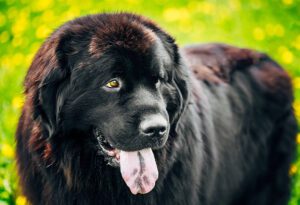
Image Credit- Getty Images
Old English Sheepdog
The Old English sheepdog has one of the most recognized dog coats. These fluffy, shaggy canines need a lot of maintenance. They are affectionate, devoted creatures who are always up for a walk or a game, so they may not be low maintenance.
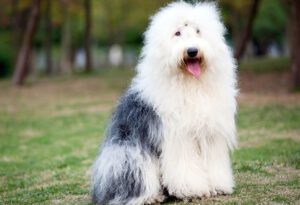
Image Credit- Getty Images
Papillon
The Papillon, an ancient breed that was once known as the Toy Spaniel, has long offered companionship. The breed’s unusual ears and mask led to the creation of the term “Papillon.” The French word for butterfly is “papillon.”
The brilliant, vivacious Papillon has long been a royal favorite due to its distinctive appearance. She is happy right now in just about any family.

Image Credit- Getty Images
Pekingese
As well as having short snouts and poofy tails, Pekingese are known for having fluffy natural hair. Please excuse these dogs if they have a tendency to be a little aloof or pompous because they were bred as pets for royalty. They genuinely care about their humans.

Image Credit- Getty Images
Pomeranian
The classic Pomeranian has a double coat of white and rusty orange fur. Although Poms come in a variety of colors, the orange-red ones best capture their vivacious spirit. You should expect to brush and play with a Pom frequently.
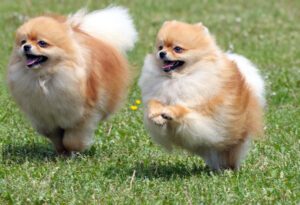
Image Credit- Getty Images
Rough Collie
Rough collies are easily recognizable by their long nose and narrow face; in addition, they have rich, billowing fur that requires frequent brushing to prevent matting, especially around the ears and haunches.
Collies were popular as family pets, especially with young children, long before Lassie came along, and they continue to uphold their reputation for devotion and friendliness.
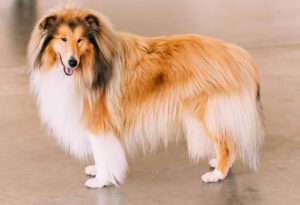
Image Credit- Getty Images
Saint Bernard
Famed for a prominent role in the old family film Beethoven, St. Bernard is also known as a literal life-saver because of his history of saving people lost in Europe’s cold Alps. Understanding, patient and placid, these enormous love bugs, which may weigh more than 180 pounds and stand around 30 inches high, are perfect for a household with little children. They shed like crazy, but a weekly brushing can cut down on the mess they make.
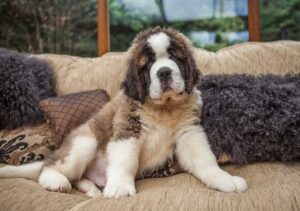
Image Credit- Getty Images
Samoyed
Samoyeds are the largest of the many adorable white fluffy dog breeds available. Herding and protecting reindeer in Siberia’s subzero weather is where this breed got its start.
Even while modern Samoyeds generally lead less strenuous lives, they nonetheless thrive on regular physical activity.
Their ultra-thick double coat sheds constantly throughout the year, so always be prepared with a dog brush. One of the best Russian dog breeds, they also have a fascinating backstory.
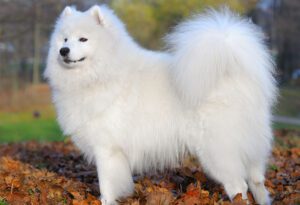
Image Credit- Getty Images
Shetland. Sheepdog (Sheltie)
Shetland sheepdogs, often known as Shelties, resemble little collies and have many of the same attributes as their larger relatives, including being extremely clever and trainable, being excellent family dogs and being born to herd.
In addition, they have a thick undercoat and long, fluffy fur, which is ideal for the cold Scottish winters but not so great for your sofa. These friendly canines require weekly brushing and regular de-matting.

Image Credit- Getty Images
Shih Tzu
Because of their rebellious nature, high energy level, and overall cuteness, Shih Tzu is often the center of attention in any group. You can tell right away that these canines were bred to be companions because of their easy going demeanor. When taken as a whole, these characteristics make the Shih Tzu an excellent companion.
However, these puppies sometimes have a lot of surplus energy that needs to be burned off through playtime, walks, or even with another Shih Tzu friend.
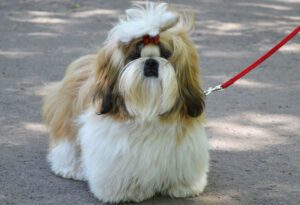
Image Credit- Getty Images
Siberian Husky
Elegant Siberian huskies often have one blue eye and one brown eye, and they are amiable with children and other animals. However, they have a strong chase instinct and require space to run…though not essential for dragging a sled across the Arctic tundra.
Insulated against the cold climate in which they originated, these gorgeous creatures require frequent brushing and de-matting but occasional bathing; they are one of the cleanest breeds available.
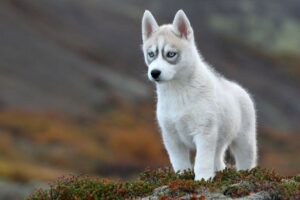
Image Credit- Getty Images
Soft-Coated Wheaten Terrier
Wheaten Terriers, often known as Soft Coated Wheaten Terriers, are one of three distinct kinds of Irish terriers.
The Wheaten Terrier is a little terrier with long legs and an extraordinarily soft, silky, and wavy coat. As the name suggests, this coat is comprised of a wheat-like pale yellow hue ranging from beige to gold. Long facial hair, which almost completely obscures the eyes, provides a distinctive and recognizable shaggy appearance.
Its initial function was to be a multipurpose farm dog that could hunt rodents, guard the chicken coop, and herd animals.
Common farmers, who were prohibited by law from possessing hounds or beagles, favored this breed in particular. As the function of farm dogs slowly diminished, the Wheaten Terrier evolved into a pet and companion.
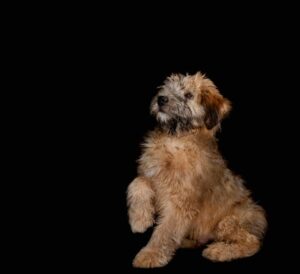
Image Credit- Getty Images
The Pyrenees
This noble creature was raised to protect sheep in the distant European mountain region from which it derives its name, so expect a dog who is at least a little bit independent and resistant to training.
In addition to being courageous and composed, they are always prepared to defend their homes with their muscular bodies, which may easily exceed 100 pounds and 32 inches in height. Equally potent is their yearly spring shedding, which paves the way for their summer coats, so be prepared to be pelted with fur. The condition can be managed with weekly brushings.

Image Credit- Getty Images
Tibetan Mastiff
The Tibetan Mastiff is a massive beast, with a maximum weight of 175 pounds and a height of 30 inches. Mastiffs, as could be expected, have a long history of service protecting livestock.
In spite of its ferocious appearance, this beast is surprisingly kind and friendly with its human companions. They prefer to spend their days relaxing at home with their loved ones and are generally calm and patient.
There are certain challenges to adopting a dog of this size. Educating and integrating children at a young age is crucial. When it comes to your mastiff, socialization is key, especially with kids, other animals, and new people. It’s a well-known fact, though, that dogs of this breed are notoriously defiant and don’t put obedience first on their list of priorities.
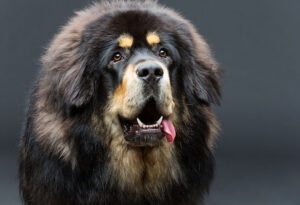
Image Credit- Getty Images
Toy Poodle
The poodle is one of the most fluffy dog breeds and is also one of the most intelligent. Their coats need regular brushing to prevent matting, but that’s a small price to pay for a dog that is so bright, active and game for anything. A Poodle is a great addition to the family because of how much fun they are to train.
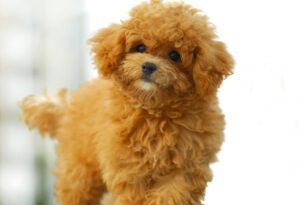
Image Credit- Getty Images
Yorkshire Terrier
It’s no secret that Yorkies think they’re the most important part of the show. When in a playful attitude, they may be pretty humorous and a lot of fun to be around because of their penchant for flamboyance. However, they are picky about who they accept inside their owners’ homes and may be aggressive with strangers or young children.
Having a high prey drive means that even the smallest sound or animal can send these dogs into a frantic state of barking (or pursuing).
While they can be difficult to live with at times, their owners are assured of their undying affection. Just be aware that sometimes with all that love comes jealousy.
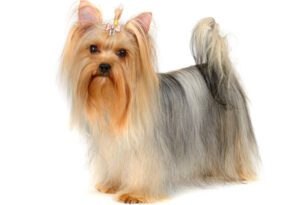
Image Credit- Getty Images
Grooming needs of fluffy coat
Creating a routine is the simplest approach to maintaining a dog’s grooming regimen. Every two to three months, you will need to bathe your dog’s fur (sometimes more if your dog gets messy). Additionally, you will need to brush your dog’s coat many times every week. We recommend scheduling an appointment with a groomer for clipper-based removal of excess fur.
To determine exactly how you will need to groom your dog, you must conduct a breed-specific study. Look up the dog’s breed for more precise advice, or speak with the breeder. A skilled groomer can also offer suggestions.
Other important considerations include the following:
Start early:
Brushing your dog will be an important component of his or her grooming regimen. The sooner you can familiarize your puppy with the brush, the better. Offer a high-value treat at the completion of each session to entice them to remain still during brushings.
Before bathing, untangle:
Remember, if you’re going to bathe your dog, you’ll need to untangle and brush its fur prior to beginning the cleaning process. When your fluffy dog already has mats and knots, adding water will only make matters worse.
Try regular trims:
If your dog tends to overheat in the summer or if you struggle to manage excessive knots, you may want to consider clipping your dog’s coat to a more manageable length.
To Sum Up
As you can see, then, the options for cute, fluffy dogs are extensive. To find the ideal fluffy dog breed for your house and family, consider the information presented in this article. All fluffy dog breeds require regular brushing and exercise, and you’ll need to get out of the vacuum frequently to keep the house smelling and looking fresh.
